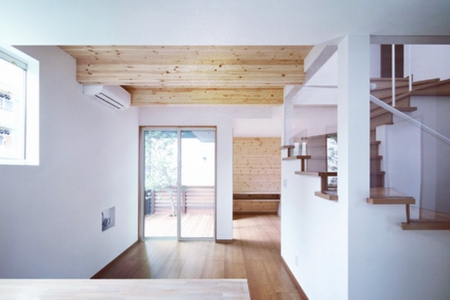建築に思って欲しいこと
建築をどうやって認識するかなんて考えたことが無い人がほとんどだろう、どうやって利用するかは考えるだろうけれども。
建築をつくる側にいると、この建築はどのように見えるのだろうか、どのように感じるのだろうか、この空間に入った時、光の見え方はどうだろうか、視線がどのように抜けていくだろうか、歩きながら目線が連続的に変化していく中で、何を感じ、何を見て、どのように思うだろうか、時には歩き、時には座り、時には立ち止まる、そうやって、設計時から抱いていたイメージと現実を擦り合わせし、住宅ならば、ここでこれから暮らしをはじめるクライアントに想いを馳せ、修正した方がいいと思えば、その場で変更を加えたりもする。
まず最初に建築をどうやって認識するかから入る。それは建築を学びはじめた時から当たり前のように行ってきたことだが、クライアント側に立てば、決してそれは当たり前のことでは無くて、広さや大きさや使い勝手などが一番最初に大事なことになり、それは建築そのものの建築的な価値を見るというよりは、不動産としての建築の価値を見るようである。
建築には事業という側面もあるのだから、不動産としての価値が大事なのも当たり前ではあり、それを第一に持ってくるのは仕方が無い場合もあるが、それでは立つ場所や予算や広さ、大きさで優劣が決まってしまうかもしれない、それは惜しい。
建築をどうやって利用するかは少し抑えめにして、建築そのものをどうやって感じて、どのように認識するのがいいのだろうか、暮らしのためには、という考え方もあるかもしれないと思って欲しい。
"What you want the architecture to think about"
Most people haven't thought about how to recognize architecture, though they will wonder how to use it.
If you are on the side of building architecture, what does this building look like, how do you feel it, how does the light look when you enter this space, how do you gaze? What do you feel, what you see and what do you think, while your eyes are changing continuously while walking, sometimes walking, sometimes sitting, sometimes stopping, so from the time of designing If you think it is better to revise the image you were embracing and the reality, to think about the housing you are living in here, and make corrections, you can make changes on the spot.
First of all, we start by how to recognize architecture. It's been a matter of course since I started to learn architecture, but on the client side, it's not a matter of course, but the size, size, and usability are the most important things. It seems to see the value of architecture as real estate, rather than the architectural value of architecture itself.
Since there is also a business aspect to construction, it is natural that the value as real estate is important, and it may be unavoidable to bring it first, but then, where it stands, budget and area, It might be decided that the size is superior or inferior, which is a shame.
I think that there may be a way of thinking about how to use architecture, how it should be felt and how it should be perceived, while limiting how it is used.


